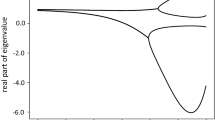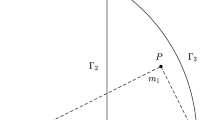Abstract
This paper investigates the equinoctial orbit elements for the two-body problem, showing that the associated matrices are free from singularities for zero eccentricities and zero and ninety degree inclinations. The matrix of the partial derivatives of the position and velocity vectors with respect to the orbit elements is given explicitly, together with the matrix of inverse partial derivatives, in order to facilitate construction of the matrizant (state transition matrix) corresponding to these elements. The Lagrange and Poisson bracket matrices are also given. The application of the equinoctial orbit elements to general and special perturbations is discussed.
Similar content being viewed by others
References
Arsenault, J. L., Ford, K. C., and Koskela, P. E.: 1970, ‘Orbit Determination Using Analytic Partial Derivatives of Perturbed Motion,’AIAA J. 8, 4–12.
Broucke, R.: 1969, ‘Perturbations in Rectangular Coordinates by Iteration,’Celest. Mech. 1, 110–126.
Broucke, R.: 1970, ‘On the Matrizant of the Two-Body Problem,’Astron. Astrophys. 6, 173–182.
Broucke, R. and Cefola, P.: 1961, ‘Properties of the Equinoctial Orbit Elements’, presented at the Theoretical Mechanics Branch Thirteenth Semi-Annual Astrodynamics Conference, Goddard Space Flight Center, April 14, 1971 (copies of manuscript available from the authors).
Brouwer, D. and Clemence, G.: 1961,Methods of Celestial Mechanics, New York Academic Press.
Chebotarev, G. A.: 1967,Analytical and Numerical Methods of Celestial Mechanics, Amsterdam-Elsevier, (translated from Russian).
Corben, H. C. and Stehle, P.: 1966,Classical Mechanics, (4th ed.), New York, John Wiley.
Deprit, A. and Rom, A.: 1970, The Main Problem of Artificial Satellite Theory for Small and Moderate Eccentricities,’Celest. Mech. 2, 166–206.
Escobal, P.: 1965,Methods of Orbit Determination, New York, John Wiley.
Goldstein, H.: 1950,Classical Mechanics, New York, Addison-Wesley.
Goodyer, W.: 1965, ‘Completely General Closed-Form Solution for Coordinates and Partial Derivatives of the Two-Body Problem,’Astron. J. 70, 189–192.
Moulton, F. R.: 1970,An Introduction to Celestial Mechanics (second revised ed.), New York, Dover Publ.
Author information
Authors and Affiliations
Additional information
This work was initiated while the second author was a Postdoctoral Scholar in the School of Engineering and Applied Science, University of California, Los Angeles.
Rights and permissions
About this article
Cite this article
Broucke, R.A., Cefola, P.J. On the equinoctial orbit elements. Celestial Mechanics 5, 303–310 (1972). https://doi.org/10.1007/BF01228432
Received:
Issue Date:
DOI: https://doi.org/10.1007/BF01228432




